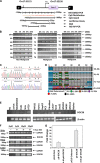DNA promoter methylation-dependent transcription of the double C2-like domain β (DOC2B) gene regulates tumor growth in human cervical cancer
- PMID: 24570007
- PMCID: PMC4036182
- DOI: 10.1074/jbc.M113.491506
DNA promoter methylation-dependent transcription of the double C2-like domain β (DOC2B) gene regulates tumor growth in human cervical cancer
Abstract
Double C2-like domain β (DOC2B) gene encodes for a calcium-binding protein, which is involved in neurotransmitter release, sorting, and exocytosis. We have identified the promoter region of the DOC2B gene as hypermethylated in pre-malignant, malignant cervical tissues, and cervical cancer cell lines by methylation-sensitive dimethyl sulfoxide-polymerase chain reaction and bisulfite genome sequencing; whereas, it was unmethylated in normal cervical tissues (p < 0.05). The promoter hypermethylation was inversely associated with mRNA expression in SiHa, CaSki, and HeLa cells and treatment with demethylating agent 5-aza-2-deoxycytidine restored DOC2B expression. The region -630 to +25 bp of the DOC2B gene showed robust promoter activity by a luciferase reporter assay and was inhibited by in vitro artificial methylation with Sss1 methylase prior to transient transfections. Overexpression of the DOC2B gene in SiHa cells when compared with controls showed significantly reduced colony formation, cell proliferation, induced cell cycle arrest, and repressed cell migration and invasion (p < 0.05). Ectopic expression of DOC2B resulted in anoikis-mediated cell death and repressed tumor growth in a nude mice xenograft model (p < 0.05). DOC2B expressing cells showed a significant increase in intracellular calcium level (p < 0.05), impaired AKT1 and ERK1/2 signaling, and induced actin cytoskeleton remodeling. Our results show that promoter hypermethylation and silencing of the DOC2B gene is an early and frequent event during cervical carcinogenesis and whose reduced expression due to DNA promoter methylation may lead to selective cervical tumor growth.
Keywords: Actin Remodeling; Akt; Cell Growth; Cell Invasion; Cell Motility; Cervical Cancer; DNA Promoter Methylation; DOC2B; ERK; Human Papillomavirus.
Figures








Similar articles
-
Metastatic suppression by DOC2B is mediated by inhibition of epithelial-mesenchymal transition and induction of senescence.Cell Biol Toxicol. 2022 Apr;38(2):237-258. doi: 10.1007/s10565-021-09598-w. Epub 2021 Mar 24. Cell Biol Toxicol. 2022. PMID: 33758996 Free PMC article.
-
Biological functions of extracellular vesicle double C2-like domain beta in cervical cancer.Sci Rep. 2025 Jan 2;15(1):477. doi: 10.1038/s41598-024-84643-2. Sci Rep. 2025. PMID: 39747389 Free PMC article.
-
Aberrant Hypermethylation of SALL3 with HPV Involvement Contributes to the Carcinogenesis of Cervical Cancer.PLoS One. 2015 Dec 23;10(12):e0145700. doi: 10.1371/journal.pone.0145700. eCollection 2015. PLoS One. 2015. PMID: 26697877 Free PMC article.
-
Wnt inhibitory factor 1 induces apoptosis and inhibits cervical cancer growth, invasion and angiogenesis in vivo.Oncogene. 2012 May 31;31(22):2725-37. doi: 10.1038/onc.2011.455. Epub 2011 Oct 17. Oncogene. 2012. PMID: 22002305
-
[Relationship between RAR-beta gene expression defect and its methylation].Zhonghua Fu Chan Ke Za Zhi. 2007 Jul;42(7):472-6. Zhonghua Fu Chan Ke Za Zhi. 2007. PMID: 17961338 Chinese.
Cited by
-
Identification and characterization of methylation-dependent/independent DNA regulatory elements in the human SLC9B1 gene.Gene. 2015 May 1;561(2):235-48. doi: 10.1016/j.gene.2015.02.050. Epub 2015 Feb 19. Gene. 2015. PMID: 25701605 Free PMC article.
-
TC2N, a novel oncogene, accelerates tumor progression by suppressing p53 signaling pathway in lung cancer.Cell Death Differ. 2019 Jul;26(7):1235-1250. doi: 10.1038/s41418-018-0202-8. Epub 2018 Sep 25. Cell Death Differ. 2019. PMID: 30254375 Free PMC article.
-
Exocytosis proteins as novel targets for diabetes prevention and/or remediation?Am J Physiol Regul Integr Comp Physiol. 2017 May 1;312(5):R739-R752. doi: 10.1152/ajpregu.00002.2017. Epub 2017 Mar 29. Am J Physiol Regul Integr Comp Physiol. 2017. PMID: 28356294 Free PMC article. Review.
-
Recent findings on epigenetic gene abnormalities involved in uterine cancer.Mol Clin Oncol. 2017 Nov;7(5):733-737. doi: 10.3892/mco.2017.1428. Epub 2017 Sep 20. Mol Clin Oncol. 2017. PMID: 29181164 Free PMC article.
-
Exocytosis Protein DOC2B as a Biomarker of Type 1 Diabetes.J Clin Endocrinol Metab. 2018 May 1;103(5):1966-1976. doi: 10.1210/jc.2017-02492. J Clin Endocrinol Metab. 2018. PMID: 29506054 Free PMC article.
References
-
- Esteller M. (2008) Epigenetics in cancer. N. Engl. J. Med. 358, 1148–1159 - PubMed
-
- Duncan R. R., Shipston M. J., Chow R. H. (2000) Double C2 protein. A review. Biochimie 82, 421–426 - PubMed
-
- Orita S., Sasaki T., Naito A., Komuro R., Ohtsuka T., Maeda M., Suzuki H., Igarashi H., Takai Y. (1995) Doc2: a novel brain protein having two repeated C2-like domains. Biochem. Biophys. Res. Commun. 206, 439–448 - PubMed
Publication types
MeSH terms
Substances
LinkOut - more resources
Full Text Sources
Other Literature Sources
Medical
Molecular Biology Databases
Miscellaneous

